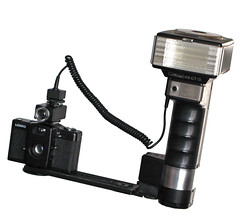Mecablitz
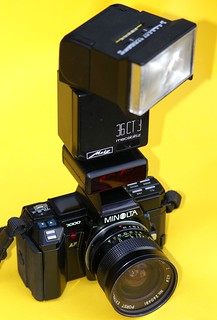
|
| Mecablitz 36 CT 3 on a Minolta 7000 image by Uwe Kulick (Image rights) |
Metz Mecablitz is a series of amateur and professional electronic flashguns. Metz also developed SCA adapters allowing their flash units to be used on different cameras and provide full facilities, such as TTL operation. Metz introduced the SCA standard adapter together with six other European firms (Osram, Agfa, Braun, Bauer, Regula and Paffrath & Kemper) at the 1982 Photokina[1].
Contents
SCA
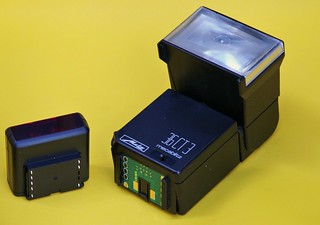
|
| Adapter Metz SCA 332 RL and Mecablitz 36 CT 3 image by Uwe Kulick (Image rights) |
The Metz SCA flash connectors ("System Camera Adapter") were launched in 1979 and comprises a range of adapters for different cameras. As flash units became more complex, offering TTL measurement and viewfinder status, each camera manufacturer developed their own proprietary contact system on the hotshoe. As well as the standard central flash trigger connection, other pins are provided for additional functions. Metz developed the SCA connectors to allow their flash units to be used on different cameras with full functionality.
SCA connectors have evolved through several generations, starting with the SCA 300 (1979) with cables SCA 500 for analog communication between camera and flash, and finally SCA 3000 (2000) which allowed digital communication between camera and flash.
The basic adapter is the SCA 301 which can be used on every standard hot shoe. Some adapters add extra functionality like the autofocus-aiding red light. The Metz SCA 332 RL is an example which adds an AF aid light and connects a Mecablitz flash unit of the System SCA 300 to the Minolta 7000 SLR camera. Some other flash makers offer flash units which use Metz SCA adapters, for example the electronic flashguns of Cullmann, Starblitz and Osram.
SCA system modules
Analog Communication
- SCA 301 - standard hot shoe
- SCA 311 - Canon - A, T, New F-1, EOS wo AF assist
- SCA 312/2 AF - Canon EOS
- SCA 321 - Olympus OM
- SCA 330 - Minolta - XD, XG, X-300, X-370
- SCA 331 - Minolta
- SCA 333/2 AF - Minolta Dynax Maxxum Alpha
- SCA 340 - Nikon
- SCA 343 - Nikon - EM, FA, FE, most AF
- SCA 344 - Nikon F3
- SCA 346/2 AF - Nikon
- SCA 350 - Leica R4
- SCA 351 - Leica - R4-R7
- SCA 356 - Rollei
- SCA 363 - Ricoh
- SCA 364 - Ricoh
- SCA 372 - Pentax
- SCA 373/2 - Pentax
- SCA 380 - Contax / Yashica
- SCA 382 - Contax / Yashica
- SCA 386 - Bronica
- SCA 390 - Hasselblad
- SCA 395 - Mamiya RZ
- SCA 396 - Mamiya 645 Pro TL
- SCA 551 - Leica
Digital Communication
- SCA 3102 - Canon - ETTL
- SCA 3202 - Olympus
- SCA 3301/N - Minolta
- SCA 3302 - Minolta / Sony
- SCA 3401 - Nikon
- SCA 3402 - Nikon
- SCA 3501 - Leica R8, R9, M6, M7
- SCA 3502 - Leica M8, M9
- SCA 3562 - Rollei 6008, Hy6
- SCA 3702 - Pentax
- SCA 3802 - Contax
- SCA 3902 - Hasselblad H series
- SCA 3952 - Mamiya 645 AF / ZD
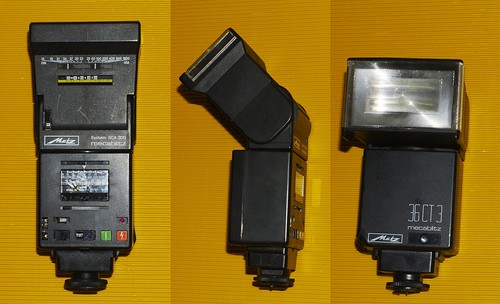
|
| Metz Mecablitz 36 CT 3 image by Uwe Kulick (Image rights) |
Flash units
Metz Mecablitz 32 series
Metz introduced the Mecablitz 32 CT 2 with the SCA system at the 1982 Photokina[2]. The Mecablitz 32 Z-1, 32 Z-2 and 32 MZ-3 were introduced at the 1992 Photokina, supporting both the old 300 type and new 3000 type SCA adapter[3].
Metz Mecablitz 36 series
Metz introduced the Metz Mecablitz 36 CT 2 with the SCA system at the 1982 Photokina[4].
The Metz Mecablitz 36 CT 3 is a flash for the ambitious amateur, compact and yet powerful. It was introduced at the 1984 Photokina[5]. The 36 CT 3 flash head can be set to indirect lightning positions 45°, 60°, 75° or 90° upwards, or into normal straight-forward lightning position or the same position with the close-up variations 5° or 10° downwards. The flash head can also be turned horizontally, up to 180° to the right or 90° to the left. On the flash light part is an uncoupled analog calculator to see which film-speed/aperture combination allows which distance in feet or metres. A second analog calculator is coupled to the electronic settings switch on the back. This calculator also shows different distances for wide, normal and tele lenses. And it switches the electronics to settings for apertures 11, 8, 5.6, 4 or 2.8, or to a TTL mode, or to the M mode (manual full output), or W (winder) mode. The uncoupled analog calculator can be switched from M to W mode or vice versa. Thus this uncoupled calculator supports aperture setting calculations for the manual and winder modes.
The flash belongs to the SCA 300 system. That means that its foot can be exchanged with a special foot for a certain camera's special hot shoe.
Metz Mecablitz 38 CT 3

|
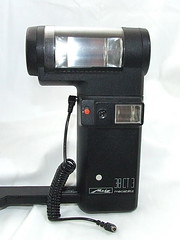
|
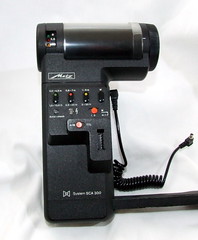
|
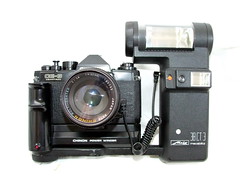
|
|
Metz Mecablitz 38CT3 flashgun, on Chinon CE-3 Memotron | |||
Metz Mecablitz 40 series
Metz introduced the Metz Mecablitz 40 MZ-2 at the 1992 Photokina, supporting both the old 300 type and new 3000 type SCA adapter[6].
Metz Mecablitz 45 series
|
More than any other flash unit, the 45 series established the reputation of Mecablitz for professional use. Powerful, reasonably compact using internal power, but also with the possibility of external power packs for extended use. Featuring a coupled computer dial / power setting, most versions with small fill in flash head, and most offering TTL exposure. Camera connection is made using a standard PC cable or SCA connector and cable to hot shoe.
The distinctive large main setting and readout dial offers six automatic settings, TTL (where applicable), M, M 1/2, M 1/4, and W (winder, low power for sequence shooting).
The main flash head may be tilted upwards and swivelled to either side.
Manufactured over several decades, the 45 CL-4 was available at least until 2012.
Mecablitz 45 versions
- CT-1 Main flash only, no TTL
- CT-3 Main flash only, TTL (Introduced at the 1984 Photokina[7])
- CT-4 Main + fill in flash (Introduced with the SCA system at the 1982 Photokina[8])
- CT-5 Main + fill in flash
- CL-1 Main flash only
- CL-3 Main + fill in flash
- CL-4 Main + fill in flash
Metz Mecablitz 60 series
The most powerful flash unit offered by Metz, its size and bulk limited general appeal. Always used with an external power pack, usually a small 6V lead/acid battery as used for small motor bikes, the weight was considerable.
Mecablitz 60 versions
- CT-1 Main flash only
- CT-2 Main flash only
- CT-4 Main + fill in flash
Notes
- ↑ Popular Photography, January 1983 p. 64
- ↑ Popular Photography, January 1983 p. 64
- ↑ Popular Photography, June 1993 p. 56
- ↑ Popular Photography, January 1983 p. 64
- ↑ Popular Photography, January 1985 p. 60
- ↑ Popular Photography, January 1983 p. 64
- ↑ Popular Photography, January 1985 p. 60
- ↑ Popular Photography, January 1983 p. 64
Links
- Flash units at Metz Mecatech (archived)
- Instruction manuals (English language) at Metz Mecablitz (archived).
- Metz Mecablitz electronic flash PDF manuals at OrphanCameras.com
